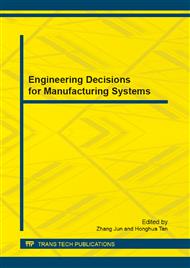[1]
M. Sun, F. Zhang, Z.H. Tong, G.P. Sheng, Y.Z. Chen, Y. Zhao, Y.P. Chen, S.Y. Zhou, G. Liu, Y.C. Tian, H.Q. Yu: Biosens. Bioelec Vol. 26 (2010), p.338.
Google Scholar
[2]
Y. Qiao, S.J. Bao, C.M. Li, X.Q. Cui, Z.S. Lu, J. Bao: ACS Nano Vol. 2 (2008) 113.
Google Scholar
[3]
Y. Mishing, in: Diffusion Processes in Advanced Technological Materials, edtied by D. Gupta Noyes Publications/William Andrew Publising, Norwich, NY (2004), in press.
Google Scholar
[4]
I.S. Kim, K.J. Chae, M.J. Choi, W. Verstraete: Environ. Eng. Res. Vol. 13 (2008), p.51.
Google Scholar
[5]
A. Heijne, H.V.M. Hamelers, M. Saakes, C.J.N. Buisman: Electrochim. Acta Vol. 53 (2008), p.5697.
Google Scholar
[6]
J.R. Kim, S.H. Jung, J.M. Regan, B.E. Logan: Bioresour. Technol. Vol. 98 (2007), p.2568.
Google Scholar
[7]
B.E. Logan: Environ Sci Technol Vol. 38(2004), p.5809.
Google Scholar
[8]
B. Ozkaya, B. Akoglu, D. Karadag, G. Aci, E. Taskan, H. Hasar: Bioproc&Biosys. Eng. Vol. 35 (2012), p.1219.
Google Scholar
[9]
N. Zhu, X. Cheni, T. Zhang, P. Wu, P. Li, J. Wu: Bioresour. Technol. Vol. 120 (2011), p.422.
Google Scholar
[10]
D.H. Park, J.G. Zeikus: Appl. Microbiol. Biotechnol. Vol. 59 (2002), p.58.
Google Scholar
[11]
K. Watanabe: J. Biosci. Bioeng. Vol. 106 (2008), p.528.
Google Scholar
[12]
U. Schröder, J. Niessen, F. Scholz: Angew. Chem. Int. Edit. Vol. 42 (2003), p.2880.
Google Scholar
[13]
J.M. Morris, S. Jin, J.Q. Wang, C.Z. Zhu, M.A. Urynowicz: Electrochem. Commun. Vol. 9(2007), p.1730.
Google Scholar
[14]
K. Rabaey, N. Boon, S.D. Siciliano, M. Verhaege, W. Verstraete: Appl. Environ. Microbiol. Vol. 70(2004), p.5373.
DOI: 10.1128/aem.70.9.5373-5382.2004
Google Scholar
[15]
Z. Hu: J Power Sources Vol. 179(2008), p.27.
Google Scholar
[16]
A.P. Borole, C.Y. Hamilton, T.A. Vishnivetskaya, D. Leak, C. Andras, J. Morrell-Falvey, M. Keller, B. Davison: J Power Sources Vol. 191(2009), p.520.
DOI: 10.1016/j.jpowsour.2009.02.006
Google Scholar
[17]
S. Xu, H. Liu: J. Appl. Microbiol. Vol. 111(2011), p.1108.
Google Scholar
[18]
J. Lee, N.T. Phung, I.S. Chang, B.H. Kim, H.C. Sung, FEMS Microbiol. Lett. Vol. 223(2003), p.185.
Google Scholar
[19]
G.T. Kim, G. Webster, J.W. Wimpenny, B.H. Kim, H.J. Kim, A.J. Weightman: J. Appl. Microbiol. Vol. 101(2006), p.698.
Google Scholar
[20]
D.R. Bond, D.R. Lovley: Appl. Environ. Microbiol. Vol. 69(2003), p.1548.
Google Scholar


